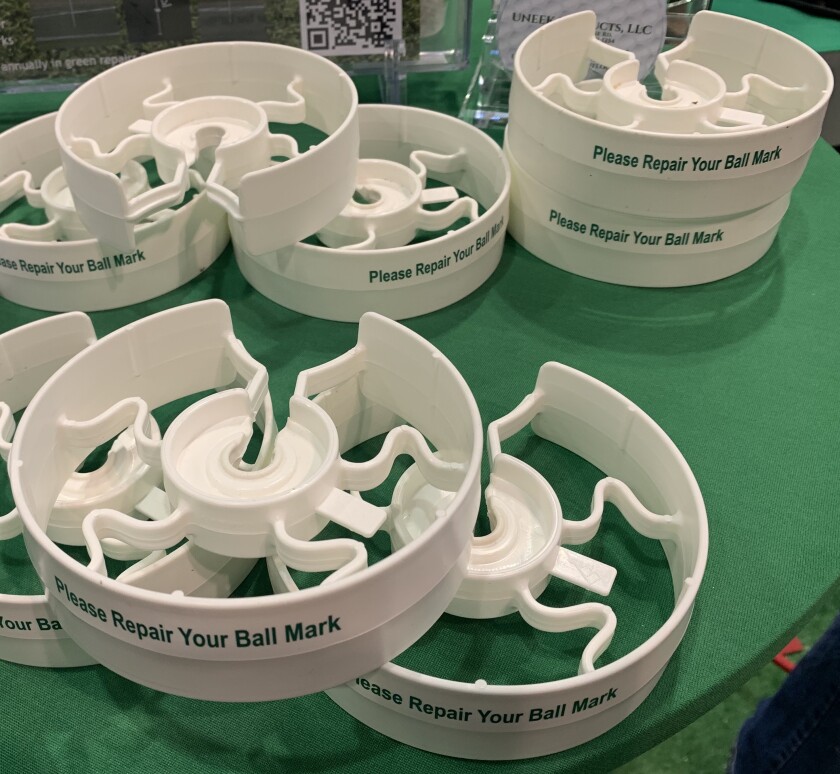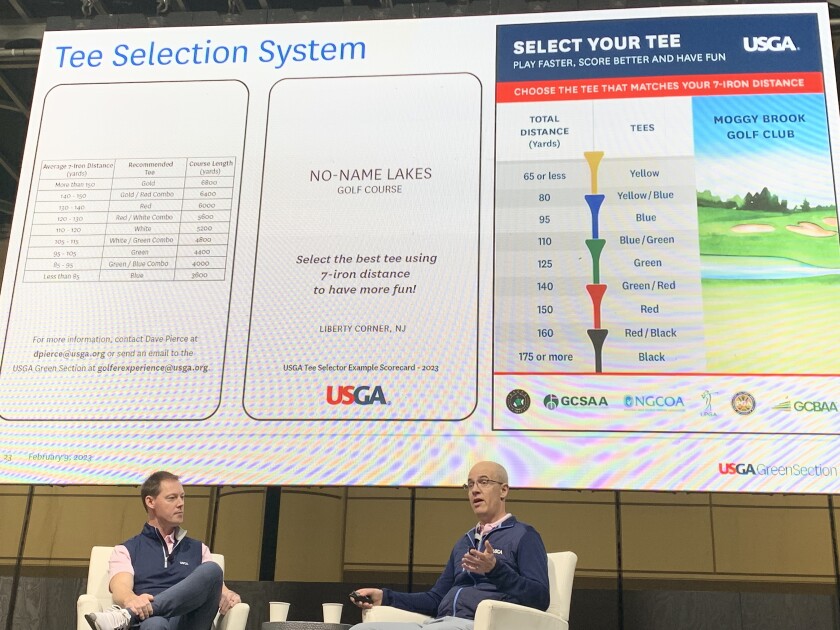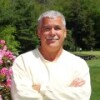
ORLANDO — When your company is doing business with the likes of Tiger Woods, Hall of Fame announcer Jim Nantz and star actor Mark Wahlberg, you know you are onto something good.
That’s the type of company Back Nine Greens is keeping these days. The California-based company designs and installs custom putting greens and artificial grass installations throughout the United States and globally, including Spain, Mexico and the Dominican Republic.
Back Nine Greens has been around for 26 years and installed the first holes for PopStroke, a technology-infused golf-entertainment concept featuring professionally designed artificial grass putting courses and top-notch food and beverage, in Port St. Lucie, Florida. Woods partnered with PopStroke in October 2019.
"Everything exploded for us when Tiger Woods bought PopStroke," says Back Nine Greens sales executive Todd Adamson, who was in attendance at the annual Golf Course Superintendents Association of America Conference and Trade Show.
2023 GCSAA CONFERENCE AND TRADE SHOW
> More to PGA Tour setups than meets the eye
> Bunker Wizard takes smooth sand to new level
> Painting a course? By the numbers it makes sense
Back Nine Greens also designed a large layout at Wahlberg’s home in Los Angeles, and the actor recently called the company again to add some spice to his backyard at Gozzer Ranch Golf and Lake Club in Idaho.
And the Nantz piece may be the coolest of them all. Back Nine Greens installed a replica of the seventh hole at Pebble Beach in Nantz's backyard near the famed resort.
"The benefits of what we do is it looks great all the time," Adamson says. "We call what we do golf art. Our bunkers are white turf and not sand so they stay white and they look nice. There is zero maintenance. You can blow it off with a leaf blower and that’s all you need. Maybe once a year we come out and brush it up and do a little maintenance on it."
How much does it all cost?
Adamson recently installed a project in California that was two greens and two tee boxes for around $100,000.
"There is a premium for it up front but then there is no maintenance after that. There is a huge benefit to that," he says. “I can only imagine where the business is going. There are endless possibilities for this."
HEY, DON'T FORGET TO GET THE PIN
Mike and Melissa Moran are both engineers living in Michigan, but were in Florida recently visiting parents when their minds started working overtime as they watched hundreds of seniors playing rounds of golf.

Many had suction cups on the end of putters to pick the ball out of the cup, but Mike Moran noticed one thing that stuck out to him.
"They still had to bend over to pick up the flag," he says.
So the husband and wife team went to work and invented a product called the Halo Advantage, a piece of molded plastic that snaps into a flag stick that serves numerous purposes.
The product does the following:
- Keeps the flagstick and clubs elevated off the ground and eliminates the need for players to bend over.
- Can highlight the day’s pin placement with adjustable flagstick positioning.
- Is easily and quickly detected by range finders.
- Helps to keep golfers from dragging the flagstick, which can damage greens.
The cost is $250 for 18 and the product was launched in 2022. The Halo Advantage comes in white, red and blue.
The standard, gentle reminder on each Halo Advantage is "Please Repair Your Ball Mark," but the couple has gotten feedback asking for customization — course logos or even restaurants asking to place a QR code that golfers can scan during a round.
“We’re both engineers, so we want to make things that make life better," Melissa Moran says.

KNOW YOUR NUMBERS
Do you know how far you hit your driver? How about your 7-iron?
If the answer is nope, don’t worry, you’re far from alone.
The United States Golf Association released some interesting performance data figures Thursday in regards to how and why golfers play from certain tees as part of its two-year study of more than 20,000 players nationwide.
The USGA findings show that 56% of all golfers surveyed have never measured their actual hitting distance.
So, the point is, how do you know what tees you should be playing if you don’t know how far you hit the ball on average? Probably a tee or two up from where you actually play considering that the survey showed there was an 8.7% difference between a golfer’s estimated distance and actual measured distance.
For a 7-iron it was 4.2%.
"The longer the club was the more golfers tended to overestimate how far they hit it," says George Waters, a Tee Up For Success seminar presenter with the USGA. "Ten percent may not sound like a big error but if you hit the ball 220 yards and you think you hit it 245 that’s a big difference in decision-making."
Waters also said it can tarnish a round of golf that may have not been too bad after all.
"You may leave a round thinking ‘Oh man, I really didn’t have it today’ and it may not be true, it’s actually how you play golf and you played a normal round but you didn’t know it because you overestimated your ability and played from the wrong set of tees," he says.
Hitting technologies are becoming more affordable, "So I’m guessing over the next five to 10 years we’ll be able to address this challenge," Waters says.
Waters also unveiled a 7-iron chart that that USGA is planning on releasing in the future that will match up how far you hit that club to what tees a course recommends you play.
"We’re doing some beta testing now to see how golfers react to it in the field," he says.
Waters said even the color of tee markers can skew what set of tees a player chooses.
"It’s a silly thing, but it does play into people’s minds," he says. "People think of the red tees as ladies tees, that color alone is a little bit of a flag for folks. The good thing about that is it’s one of the easiest things to change. Just put the red tee as the back tee. And there are a lot of really famous golf courses that have already done that."
Shinnecock Hills Golf Club and National Golf Links of America are just two of many that have made this color change on its tee boxes, the USGA said.
ODDS AND ENDS
The quietest sport — golf — was mixing with the loudest sport — NASCAR — at the annual GCSAA show as Xfinity Series driver Justin Allgaier was on hand with his No. 7 Brandt Professional Agriculture Camaro. Allgaier took photos with fans, signed autographs and promoted his main sponsor. "For me if you walk into a golf show or an agriculture event and we have a race car on display it can be a little bit odd," Allgaier says. "And unfortunately we can’t start it because I feel like if we could fire up the engine it would be great. But I love drawing awareness to the agriculture industry because I think a lot of the general public doesn’t necessarily understand the agriculture industry as a whole, whether it’s the food they eat of how the grass they walk on is grown. Allgaier and Brandt are beginning their 12th year of partnering as race car driver and sponsor.
NEWS: Special @BRANDT_co 70th anniversary scheme for @J_Allgaier in @DAYTONA; @miguelpaludo back in the No. 88 for three races.
— JR Motorsports (@JRMotorsports) January 17, 2023
Full story ➡️ https://t.co/iwb4UlgaU1 pic.twitter.com/VeDs4gVvQa
If your golf course has bluegrass growing on it, then there is a good chance that seed came from Barenburg, a company that has been around for more than 125 years and is the largest grass seed company in the United States. With corporate offices in Holland, the firm also has locations in Oregon and Washington state, areas ripe for bluegrass research. "At Barenburg we’re known for our technologies," says company national sales manager Cassie Kearns. "We’re in six continents — all but Antarctica — but they can’t grow grass there. And the cool thing about that is it opens us up to genetics from all around the world." … The Carolinas Section of the Golf Course Superintendents Association topped about a dozen other associations and organizations across the country in Rounds 4 Research contributions at more than $79,000. Rounds 4 Research is designed to address a critical shortage in turfgrass research funding by auctioning donated rounds of golf online. Since its launch in 2012, Rounds 4 Research has raised nearly $2.5 million. Georgia was second behind the Carolinas Section at more than $52,000, while Florida came in third at more than $45,000.











